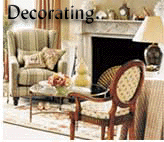|
Red
from
a psychological viewpoint represents fire, heat, anger, temper, blood,
fashion, fertility; and it means stop world-wide. It
is associated with passionate love, sex, great energy, impulse, action
and stimulation, assertivity and aggression, courage, strength and power,
adventure, Temperamental and ambitious people with a need for personal
freedom.
|
|
Blue
- A
spacy color, cool and soothing, dreamy and magical. Peace and rest.
Caution. For people who keep a certain distance, but give calm and practical
help; they are faithful and loyal, have a sense for order, logic and
rational thinking. Flying in day-dreaming, ideals or nostalgia when
felt mis-understood. Dark blue is more severe and can be melancholic.
|
|
Yellow
- The
color of the sun, life-force, vitality and energy. The color of cheerfulness,
curiosity, alternation, flexibility, progress, amusement, contact through
traveling and communication, learning and practical knowledge. A feeling
for writing and speaking. Stimulates
brain and nervous activity. energizes the muscles. speeds up the digestion
and assimilation. Activates and cheers up depressed and melancholic
people.
|
|
Childrens
-Primary red, yellow, and blue are important
for visual development of young children. Children's emotional response
to red is: Angry, thirsty, mean, sore eyes, fire, danger. Red is the
principal color pertaining to areas of basic needs, such as food, clothing
and shelter. Red has always been attractive to human beings.
|
|
Color is pure
decorating
power!
It can turn an ordinary home into something extraordinary. Color is
a guaranteed way to give your home a lift and bring out its best. When
using color in decorating our aim is to attract the attention of our
family and friends. To ensure that our family and friends are happy
and comfortable while visiting or living in our home.
You
shoud always paint patches of color on the wall to try out living with
them and looking at the true color at different times of the day...taping
up big memo samples of fabric on walls or pinning to existing furniture
and spending some time with these "tests" also helps even the professionals
make up their minds! Putting together simple boards with all the swatches
will give an overview if it's difficult to imagine it all together..."
Painting
is cheap, you can often do it yourself, and you can create a lot of
effect with color. Try a color you've never tried before -- kiwi green
or a pale violet -- something you've always wanted to try. A couple
of gallons of paint is a very inexpensive experiment."
|
|
Fashion
- Ever
wonder why you just can't part with some old piece of clothing you've
had far too long? It's probably because it evokes in you some emotion
that's comforting and that you feel nurtured by! Nature has provided
us with a spectrum of beautiful colors to nurture both body and spirit.
In the physical body, color has an effect on all body systems, affecting
everything from blood pressure and body temperature to muscular activity
and the immune system. The colors we choose supply a vital energy to
our body and spirit, boosting our health, self esteem and energy.
More noticeable to most people would be the effect of color on our emotions
and moods. It's often not a conscious choice we make when we choose
our clothing for the day, it's the "I feel like this today" part of
ourselves that we often let make this decision for us, and this unconscious
decision-maker is choosing as much for the colors we need that day as
for the style. And because we choose colors that are attuned to our
own energy state, this may indicate behavioral tendencies.
|
|
Cool
Colors are
violet, blue, light blue, cyan and sea green. these colors are known
to slow down our perception of time. They apperar like silk and professioanl
in presentations but may turn people off because of their coolness.
These colors recede into the distance. They are more suitable for backgrounds.
the cold blue, especially retreats. These colors are associated with
sadness, depression, and melancholia. Cool
colors have passive, calming qualities that aid concentration and
can create a mood of peacefulness and tranquility. Green can be either
warm or cool. When it's influenced by yellow, it becomes warm and when
it's influenced by blue, it becomes cool. When choosing colors, it is
also important to consider the effect of the lightness and darkness,
or value of color. Lighter colors tend to be more active, and deeper
colors tend to be passive.
|


